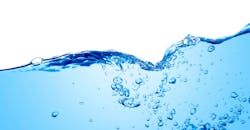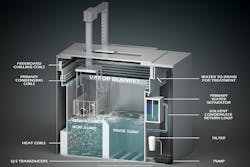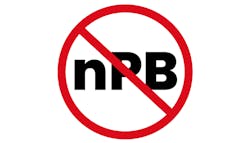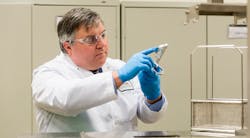Meeting the Long-term Critical Cleaning Challenge
Cleaning is an essential step in modern machining processes. Machined parts must leave the production line perfectly clean, dry, and ready for further processing.
However, manufacturing processes can leave parts contaminated with grease, machining and stamping oils, metal filings and other industrial soils. These contaminants may impair a finishing method and result in components that do not function reliably. To meet inspection standards and cleanliness specifications, contaminants must be removed.
Although there are many critical cleaning solutions available, finding a long-term process that works effectively and adjusts to changing requirements can be problematic. There are several challenges for cleaning industrial parts and surfaces. Miniaturization, complex designs, novel materials, and delicate coating technologies all make finding effective future-proofed cleaning difficult. Add to these the need for cost reduction, revised environmental regulations, and workplace safety rules, and the task seems almost impossible.
Future-proofed cleaning
As industry trends change and standards are updated, cleaning processes must be flexible and adapt quickly. Using a process that cleans well is simply not enough, it must also be future-proofed.
Vapor degreasing, used in combination with modern cleaning fluids, is the key to long-term, critically clean parts. It not only ensures the cleanliness of the component, but also meets the economic, environmental, and regulatory requirements sought by manufacturers.A vapor degreaser is a thermo-mechanical system involving two chambers: the boil sump and the rinse sump. In the boil sump, the cleaning fluid is heated, and the parts are immersed and cleaned. Once cleaned, the parts are mechanically transferred to the rinse sump for a final rinse in a pure, uncontaminated fluid. As a result, components come out clean, dry, at room temperature and immediately ready for packaging or further processing.
There are many advantages to parts cleaning with a vapor degreaser. They are fast, cost-effective, sustainable, worker-safe systems, and highly effective at trapping and removing soils from even the most complex and intricate component designs.
Meeting the sustainability challenge
Processes for cleaning and prepping parts for further processing like plating, coating, painting, or welding have evolved over recent years. For example, the metalworking industry traditionally used water cleaning or vapor degreasing with legacy solvents such as nPB (n-propyl bromide), PERC (perchloroethylene) and TCE (trichloroethylene).
Although manufacturers that used these legacy solvents may have found them highly effective and competitively priced, environmental regulatory agencies worldwide have been restricting their use due to their negative impact on the planet.
For example, in Europe the use of nPB as an industrial cleaner has been banned since 2020. It was found that nPB presents an unreasonable risk to human health when used as a cleaner inside all vapor degreasers, including open-top, in-line, and closed-loop models. Canada and Japan are already severely restricting the use of the solvent, with a ban predicted to take place imminently. The U.S. may follow suit with a complete ban soon.Manufacturers are re-evaluating their cleaning methods and looking for sustainable ways to reduce energy and water usage, lower emissions, and generate less waste, while meeting strict regulatory requirements. They are turning to vapor degreasers and newer, safer cleaning-fluid alternatives to future-proof their parts cleaning.
Modern vapor degreasing liquids typically boast a Global Warming Potential (GWP) of 10 or less, helping to reduce the GWP and harmful greenhouse gases. This starkly contrasts to past cleaning solvents like HFCs (hydrofluorocarbons) and HCFCs (hydrochlorofluorocarbons) that had GWP ratings in the thousands.
Moreover, the updated fluids are not classified as hazardous air pollutants (HAPs) due to zero ODP (Ozone Depleting Potential) and low VOC (Volatile Organic Content) ratings. Their compliance with regional air-quality regulations often excludes them from required National Emission Standards for Hazardous Air Pollutants (NESHAP) permits.
These fluids also have been specially engineered to meet environmental regulations like the U.S. Environmental Protection Agency's (EPA) and Europe's REACH (Registration, Evaluation, Authorization and Restriction of Chemicals) legislation, as well as the Significant New Alternatives Program (SNAP) and the Toxic Substance Control Act (TSCA) standards. Not only do they satisfy strict parameters relating to sustainability, but their cleaning performance remains uncompromised.
Worker safety
Of course, finding the most sustainable processes should be a priority for any parts manufacturer, but workers’ health and well-being should be the number one concern.
The properties of new cleaning fluids make them a good choice for improving environmental safety and increasing personnel protection. They are compositionally stable and non-flammable, meaning they bring greater workplace safety.
Furthermore, many nPB, PERC, or TCE substitutes have improved TLVs (Threshold Limit Values), which are used in evaluating exposure limits in parts-per-million (ppm). A higher number indicates a safer product, while low numbers signal more risk. For example, American agencies recommended 10-ppm minimum for exposure limits for nPB, whereas California adopted 5-ppm, and the ACGIH (American Conference of Governmental Industrial Hygienists) lowered their rating to just 0.1 ppm. The modern replacement fluids typically have 200-250 ppm (parts-per-million) TLV, making them significantly better for exposed workers.
Cleaning power
Vapor degreasing and new cleaning fluids address environmental and safety concerns, but consistent and effective cleaning is still important. Parts must be critically clean to avoid reliability issues and down-the-line production problems.
Modern cleaning fluids have various features beneficial to thorough cleaning and surface preparation. Their low surface tension and reduced viscosity enable them to penetrate hard-to-reach places, like small end holes. Additionally, these fluids are dense, aiding in removing all traces of foreign particulate from parts. Importantly, they evaporate and dry very quickly, leaving no contaminants or residue behind; this is particularly useful for materials vulnerable to flash rusting.When it comes to cleaning, ‘like cleans like’; a contaminant dissolves best in a solvent with a similar structure. Therefore, it important to match the fluid to the contaminant. For example, nonpolar pollutants such as coiling oils, greases and waxes should be removed using a nonpolar fluid.
Many modern cleaning fluids are lab-tested to ensure the cleaning results are reliable and consistent. They are usually formulated using a combination of ingredients to maximize the cleaning fluid’s effectiveness and material compatibility. The vapor degreaser can use a single cleaning fluid or a custom mixture to remove contamination from a specific substrate. This will help to maximize cleaning effectiveness while minimizing any surface damage.
Look to the future
Today’s production facilities necessitate high standards of cleanliness for parts leaving the manufacturing line. As such, cleaning has become more complex and challenging in an era that puts great emphasis on safety, compliance, and energy efficiency.
To fulfil these requirements, vapor degreasing is a cost-effective, consistent and more ecologically friendly solution that can adjust to emerging regulations or other environmental requirements. It also offers paramount protection to workers by providing companies with the opportunity to prioritize employee health. In addition, a modern cleaning fluid further enhances the benefits of vapor degreasing as an ideal long-term, sustainable cleaning process.
Elizabeth Norwood is a senior chemist at MicroCare LLC, a provider of precision cleaning solutions, with more than 25 years industry experience. Norwood earned a B.S. in Chemistry from the University of St. Joseph, and currently holds one patent issued and two patents pending for her work.
About the Author
Elizabeth Norwood
Senior Chemist
Elizabeth Norwood is a senior chemist at MicroCare LLC, a provider of precision cleaning solutions. With more than 25 years industry experience, Norwood researches, develops, and tests cleaning-related products. She earned a B.S. in Chemistry from the University of St. Joseph, and currently holds one patent issued and two patents pending for her work.



